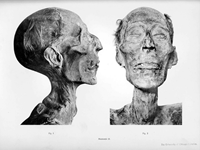In the cold waters of the Foxe Basin near Baffin Island in the Canadian Arctic, chunks of sea ice drift through swirling oil ice, forming patterns reminiscent of the clouds of gas and dust we see across the universe. Sea ice often begins as oil ice, a layer of small ice crystals on the ocean surface. Although it does not contain oil, oil ice gives the sea surface a slippery appearance. As the temperature decreases, the oil ice thickens into more solid sheets of ice. Changes in the glaciers, ocean and atmosphere in the northernmost part of the Earth have a major impact on the entire planet, because the Arctic acts as the Earth's air conditioner. Much of the sun's energy is transported by winds and weather systems from the tropical regions of our planet to the Arctic, where it is reflected back into space. This process contributes to the cooling of the planet.
The NASA/@USGS satellite Landsat 7 captured this image on 4 August 2002. Landsat 7 stopped taking scientific imagery in January 2024, but NASA continues to study sea ice in different ways. Most recently, three aircraft flew over the Arctic Ocean north of Greenland, collecting observations of surface sea ice, clouds and aerosol particles as part of a NASA-sponsored mission.
Image description:
The vibrant, deep blue waters of the Foxe Basin form the background of this image. Different types of ice swirl around in the upper and left parts of the image. Fragments of ice can be seen throughout the image, as well as more diffuse eddies that look almost like dust or sand.


 Nielawore
Nielawore









Yorum yazmak için lütfen giriş yapınız